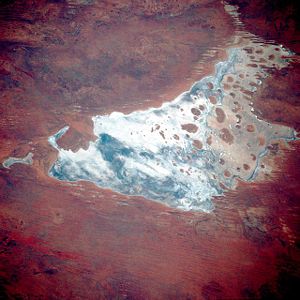
Lake Mackay
Encyclopedia

Western Australia
Western Australia is a state of Australia, occupying the entire western third of the Australian continent. It is bounded by the Indian Ocean to the north and west, the Great Australian Bight and Indian Ocean to the south, the Northern Territory to the north-east and South Australia to the south-east...
and the Northern Territory
Northern Territory
The Northern Territory is a federal territory of Australia, occupying much of the centre of the mainland continent, as well as the central northern regions...
.
The satellite image documents the appearance of the dry parts of Western Australia’s Great Sandy Desert
Great Sandy Desert
The Great Sandy Desert is a desert located in the North West of Western Australia straddling the Pilbara and southern Kimberley regions. It is the second largest desert in Australia after the Great Victoria Desert and encompasses an area of...
, Gibson Desert
Gibson Desert
The Gibson Desert covers a large dry area in the state of Western Australia and is still largely in an almost "pristine" state. It is about in size, making it the 5th largest desert in Australia, after the Great Sandy, Great Victoria, Tanami and Simpson deserts.-Location and description:The Gibson...
, and Tanami Desert
Tanami Desert
The Tanami Desert is a desert in northern Australia situated in the Northern Territory. It has a rocky terrain with small hills. The Tanami was the Northern Territory's final frontier and was not fully explored until well into the twentieth century...
.
Named after its European discoverer, Donald George Mackay
Donald George Mackay
Donald George Mackay was an Australian outdoorsman, long-distance cyclist, and explorer who conducted several expeditions to the remotest areas of the Australian continent.-Early life:...
, Lake Mackay is the second-largest lake in Australia, measuring approximately 60 miles (100 kilometers) east-west and north-south. The darker areas of the lakebed are indicative of some form of desert vegetation or algae
Algae
Algae are a large and diverse group of simple, typically autotrophic organisms, ranging from unicellular to multicellular forms, such as the giant kelps that grow to 65 meters in length. They are photosynthetic like plants, and "simple" because their tissues are not organized into the many...
, some moisture within the soils of the dry lake, and the lowest elevations where pooling of water occurs. In this arid
Arid
A region is said to be arid when it is characterized by a severe lack of available water, to the extent of hindering or even preventing the growth and development of plant and animal life...
environment, salts and other minerals are carried to the surface through capillary action caused by evaporation
Evaporation
Evaporation is a type of vaporization of a liquid that occurs only on the surface of a liquid. The other type of vaporization is boiling, which, instead, occurs on the entire mass of the liquid....
, thereby producing the white reflective surface. Visible are various brown hills scattered across the eastern half of the lake and east-west-oriented sand ridges south of the lake.
Lake Mackay features prominently in the Aboriginal
Indigenous Australians
Indigenous Australians are the original inhabitants of the Australian continent and nearby islands. The Aboriginal Indigenous Australians migrated from the Indian continent around 75,000 to 100,000 years ago....
Dreaming narratives of the Western Desert. The main mythological
Australian Aboriginal mythology
Australian Aboriginal myths are the stories traditionally performed by Aboriginal peoples within each of the language groups across Australia....
accounts of its origins can be clustered into three distinct themes, all of which contain references to a fierce bushfire that devastated the land and formed the lake .
The lake is the largest in Western Australia
Western Australia
Western Australia is a state of Australia, occupying the entire western third of the Australian continent. It is bounded by the Indian Ocean to the north and west, the Great Australian Bight and Indian Ocean to the south, the Northern Territory to the north-east and South Australia to the south-east...
and has a surface area
Surface area
Surface area is the measure of how much exposed area a solid object has, expressed in square units. Mathematical description of the surface area is considerably more involved than the definition of arc length of a curve. For polyhedra the surface area is the sum of the areas of its faces...
of 3494 square kilometres (1,349 sq mi)
The lake, known as Wilkinkarra to the local Indigenous population, was the birthplace of prominent Indigenous artist Linda Syddick Napaltjarri
Linda Syddick Napaltjarri
Linda Yunkata Syddick Napaltjarri is a Pintupi- and Pitjantjatjara- speaking Indigenous artist from Australia's Western Desert region...
.

